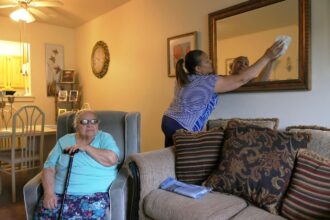I expect tomorrow’s October jobs report will be so so. Why? Tuesday’s Labor Department’s monthly Job Opening and Labor Turnover Survey (JOLTS) indicated stagnating labor demand and so do business indicators. The National Association of Business Economists mid-October reported falling sales and fewer incidences of rising sales since July.
Also, JOLTS reported hires were blah. The number of job openings changed little at 9.6 million on the last business day of September. And compared to last month, the number of hires and total separations changed little at 5.9 million and 5.5 million, respectively which means things are about even.
True, the GDP unexpected 4.9 percent growth rate for the third quarter shocked economists. But that growth rate may not signal great expectations for super-sized holiday consumer demand. The strong report may partly reflect an oversupply of inventories, which added almost a quarter of the rise.
Take a look at the “job leavers” share of total unemployed, which complements the quits rate and indicates worker confidence. The job leaver rate in June 2023 was very high at 15.8%. In September 2022, one year later a smaller share of the unemployed were job walk-awayers, just 12.5%. I expect the rate to be about the same tomorrow.
Why does the job leaver share and quits matter? Quits rates (and job leaver share) peak right before a recession. (But note Biden and the Fed avoided a recession in 2020.) When the economy starts to wane workers get worried and hang on to their jobs and they certainly don’t get raises.
I am watching out for the job leavers share of the unemployed, the direction of weekly wages increases, and anything else that might attract attention. I don’t think the headline unemployment rates will change much. It might be a dull report.
The NABE has a nifty index capturing sales momentum — the Net Rising Index (NRI) –which is the share of surveyed economists reporting rising sales minus the share reporting falling sales—is 6, down from a much higher 33 in July survey and as about as bad as the beginning of COVID-19 pandemic.
Read the full article here










